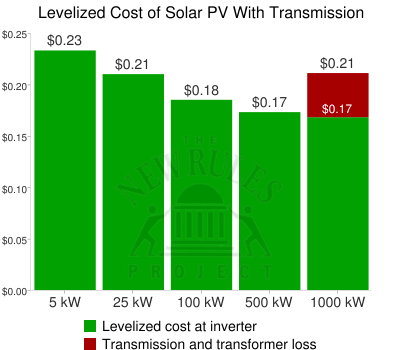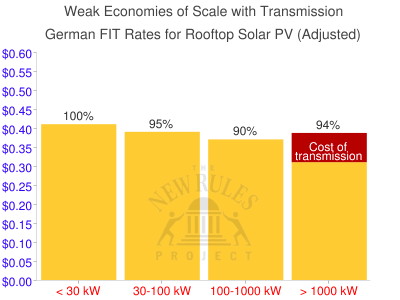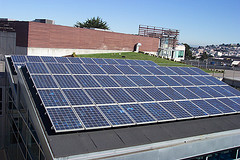Update 7/26: One commenter asserts that the loss figures offered by the original author may be relevant in India, but do not reflect the U.S. grid, where losses total around 7%. EIA data seems to reflect this [xls].
Can transmission losses completely offset economies of scale for solar power plants? An article in Renewable Energy World argues against the building of multi-megawatt (MW) solar PV instead of on-site or local PV systems. In particular, the author writes:
The biggest problem with the multi-MW solar PV plant is that it loses 12-15 percent of expensive power as it passes through a series of power transformers. PV solar inverters generate power at 400 [Volts] three-phase. In large plants, this power is first boosted to 66 [kilovolts] or more with several power transformers and then stepped down to 400V with another string of transformers to suit consumer requirements. In addition, there is a further transmission loss of 5-7 percent in the power grid. Why suffer an avoidable 20 percent loss of expensive solar power?
…There is thus no ‘scale advantage’ in large PV solar plants. In reality, all multi-MW plants are basically clusters of several 500-kW plants since solar inverter capacities are limited to about 500 kW and no more. Why not have one hundred 500 kW plants instead of one giant 50 MW plant?
With 20% of the power from a large-scale solar plant lost in transformers and power lines, it could seriously alter our previous analysis of solar economies of scale. Here are the original charts, with the first chart shows our original analysis of solar economies of scale, with strong savings for scale for new projects (as reported by the Clean Coalition):

The next chart shows the economies of scale in the German rooftop PV market, as reflected in their feed-in tariff rates. The percentages show the price in each size tranche relative to the price for the smallest rooftop PV systems. Once again, there are significant savings for scale, especially when going from a project 100-1000 kW to one that is 1 megawatt or larger (15 percent).

But if there is a 20% power loss for the voltage stepping and transmission for larger solar projects, then when it comes to delivered power, small projects may perform better. Let’s assume that projects 1 MW and larger require the voltage step and transmission (and incur the losses), whereas smaller plants do not. The following two charts illustrate the difference.
 The first chart takes the Clean Coalition (green line) data from the Solar PV Economies of Scale chart and calculates the levelized cost of the power from each size power plant based on the sunshine in southern California. For the largest size solar power plants, the cost is adjusted for the losses due to transmission and transformer stepping.
The first chart takes the Clean Coalition (green line) data from the Solar PV Economies of Scale chart and calculates the levelized cost of the power from each size power plant based on the sunshine in southern California. For the largest size solar power plants, the cost is adjusted for the losses due to transmission and transformer stepping.
As we can see in the first chart, the losses from transmission wipe out most economies of scale for large-scale solar, making 1 MW and larger solar PV plants equivalent to on-site solar power from a 25 kW solar PV array.
We can similarly examine the effect in the German case. Here the government sets the price paid for solar by size class, and since it’s based on output at the power plant, large-scale plants that have transmission losses get paid for their entire power output, regardless of how much usable power reaches customers. The following chart shows what German customers effectively pay for solar, assuming that 1 MW and larger facilities all experience the 20% transmission losses explained earlier.

As we can see in the chart, the cost of transmission can wipe out the economies of scale in installed costs, making large-scale solar comparable to solar PV of 30-100 kW, but without the same transformer and transmission losses.
It may be true that the installed costs of solar PV continue to fall as projects get larger, but it’s clear that relying on the price of solar at the power plant does not accurately reflect the cost to the grid or ratepayers. For some size of larger power plants (1 MW? 5 MW?), the lost power from stepping up and down voltage through transformers and from transmission may largely offset the economies of scale from building a larger power plant.
Rather, mid-sized solar (or specifically, projects that can connect directly into the distribution system without changing the voltage) may deliver the best cost per kilowatt-hour.



